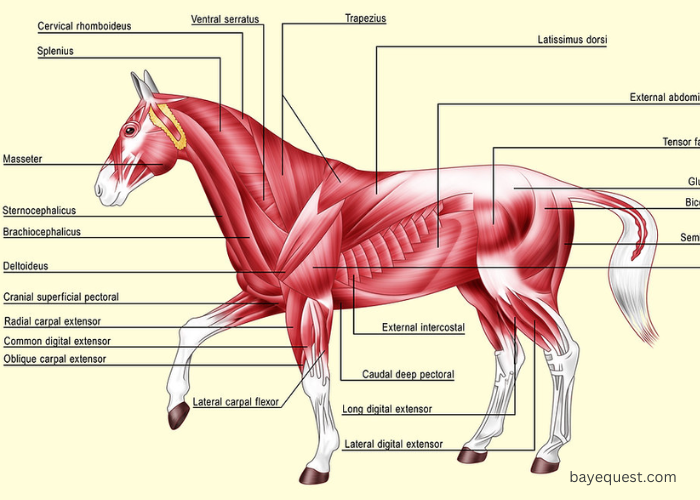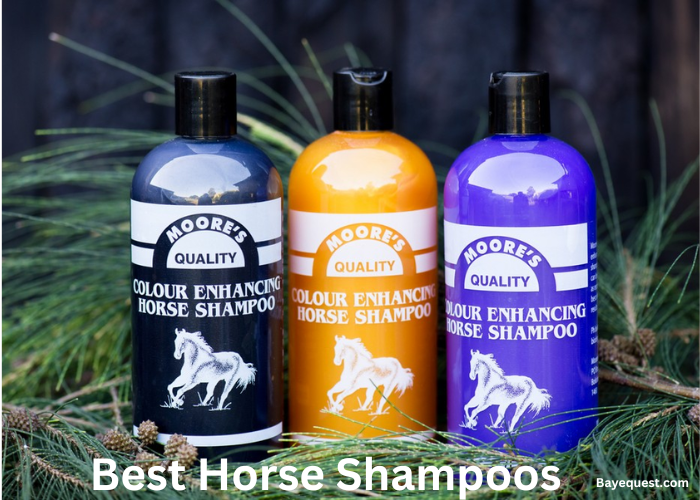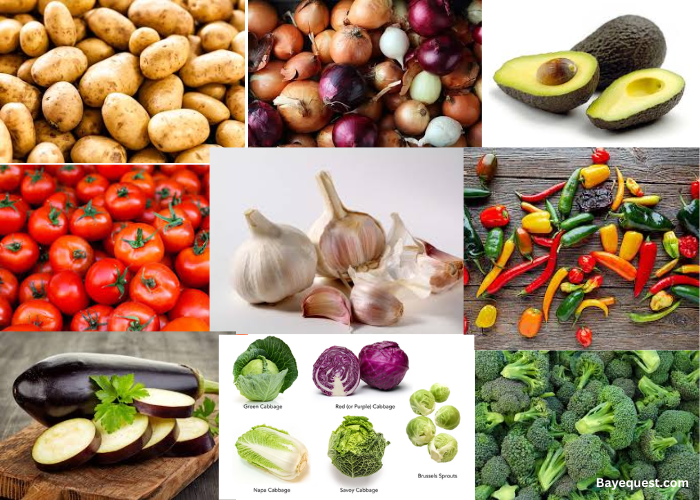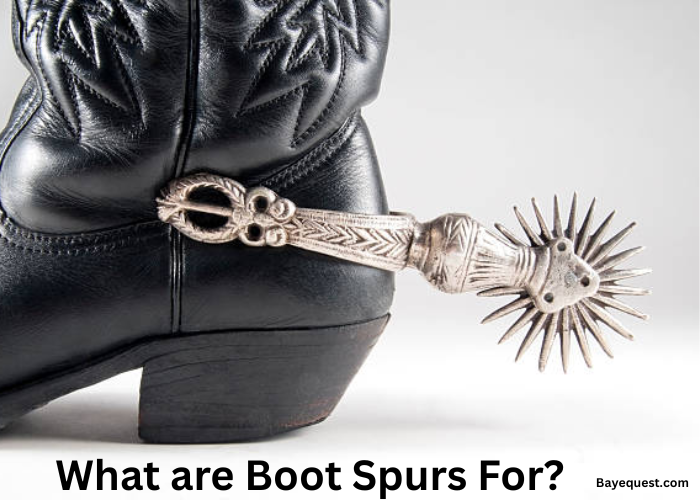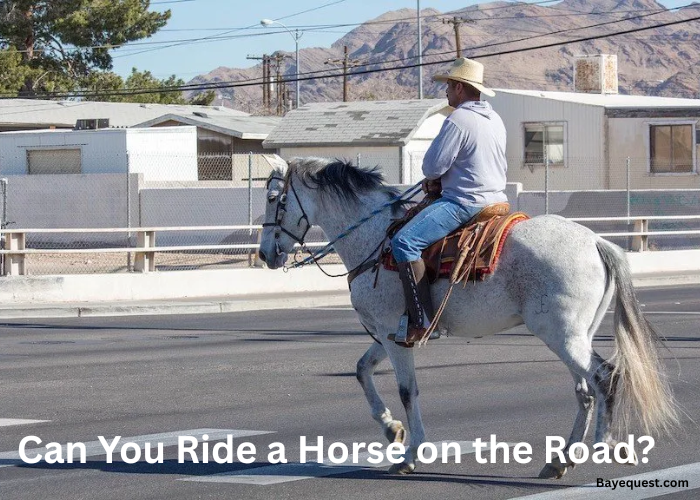Horses have strong muscles that power their movement. These muscles help them run, jump, and carry riders with ease.
But what makes them so powerful? How do they work?
Knowing horse muscle anatomy is important for any rider or owner. It helps with training, performance, and overall care.
In this blog, we’ll explore the major muscle groups, how they function, and ways to keep them healthy.
Whether you ride, train, or simply care for a horse, this guide will give you a better understanding of their muscles.
Overview of the Horse Muscle Anatomy
Horse muscles are divided into three main types: skeletal, smooth, and cardiac muscles. Each type plays a unique role in the horse’s body.
Skeletal Muscles (Voluntary Muscles)
Skeletal muscles are responsible for all of the horse’s conscious movements.
These muscles attach to bones via tendons, creating a lever system that enables the horse to move.
When a skeletal muscle contracts, it pulls on a tendon, which then moves the attached bone.
These muscles are what allow horses to perform everyday tasks like walking, trotting, and jumping.
Skeletal muscles consist of two types of fibers: slow-twitch (Type I) and fast-twitch (Type II) fibers.
Slow-twitch fibers are endurance muscles. They enable the horse to maintain steady, prolonged activities like walking and low-intensity exercise.
Fast-twitch fibers are used for explosive movements, like sprinting or jumping.
Horses bred for speed, such as racehorses, have more fast-twitch fibers, while endurance horses have more slow-twitch fibers.
Each muscle group works together to control different parts of the horse’s body.
For example, the gluteal muscles in the hindquarters generate the power behind the horse’s stride.
The pectorals in the chest control front-leg movement.
The functioning of skeletal muscles is vital for a horse’s strength, flexibility, and overall performance.
Smooth Muscles (Involuntary Muscles)
Smooth muscles work automatically without conscious control.
They are found in various internal organs, including the digestive system, respiratory system, and blood vessels.
Unlike skeletal muscles, smooth muscles are not attached to bones.
Instead, they form part of the walls of hollow organs. They help to regulate core functions like digestion and blood circulation.
In the digestive system, for instance, smooth muscles are responsible for peristalsis.
These muscles work rhythmically and continuously to push food along, ensuring that nutrients are absorbed properly and waste is expelled.
Smooth muscles in the respiratory system also help to regulate airflow by controlling the size of the airways.
Since smooth muscles are part of the autonomic nervous system, they don’t tire easily.
This allows them to function continuously throughout the horse’s life without rest.
Though they lack the power of skeletal muscles, their endurance is essential for maintaining critical life functions.
Cardiac Muscles (Heart Muscles)
Cardiac muscles are highly specialized muscles found only in the heart.
They are responsible for the heart’s pumping action, which circulates blood throughout the body.
Like smooth muscles, cardiac muscles work involuntarily.
However, cardiac muscles are uniquely adapted to work non-stop, beating rhythmically from birth until death.
Cardiac muscle fibers are branched and interconnected, forming a strong, unified structure that contracts in a coordinated way.
This ensures that each heartbeat is powerful enough to push blood through the arteries and veins.
Proper conditioning through exercise strengthens the heart, ensuring that the horse’s cardiovascular system can support strenuous activities over long periods.
Major Muscle Groups in Horses
Horses rely on key muscles for movement, strength, and performance. Let’s explore these muscles and their unique roles.
Neck (Cervical muscles)
The cervical muscles play a critical role in the movement and posture of the horse’s head and neck.
These muscles help the horse lift, lower, and turn its head, as well as maintain balance and control during movement.
Key muscles within this group include:
Splenius
Located along the top of the horse’s neck, this muscle helps lift the head and neck.
It also stabilizes the head, especially when the horse is in motion.
Brachiocephalicus
This muscle runs from the back of the horse’s head down to the upper arm.
Its primary function is to extend the head and neck forward and help stretch the forelimb.
Sternocephalicus
Situated along the lower part of the neck, this muscle helps to pull the head down and flex the neck.
It works in opposition to the splenius.
Rhomboideus
This deep muscle connects the vertebrae of the neck to the shoulder blade, aiding in lifting the shoulder and head.
Trapezius
Extending from the neck to the withers, the trapezius muscle assists in lifting the shoulder and maintaining stability during motion.
Shoulder and Forelimb muscles
The shoulder and forelimb muscles are crucial for a horse’s forward movement, stability, and strength.
These muscles power the horse’s stride, absorb impact, and help maintain balance during various activities.
Here’s a breakdown of the muscles in this group:
Trapezius
Extending from the neck to the shoulders, the trapezius muscle helps lift and stabilize the shoulder.
It has two parts, the cervical part (from the neck) and the thoracic part (from the back).
Deltoid
This muscle is located on the outer part of the shoulder and assists in flexing the shoulder joint, enabling the horse to raise its forelimb.
It helps in controlling the range of motion during forward movement.
Biceps Brachii
Running along the front of the upper arm, this muscle flexes the elbow and stabilizes the shoulder during weight-bearing activities.
It plays a key role in moving the forelimb forward and absorbing the impact when the limb touches the ground.
Latissimus Dorsi
This large, flat muscle stretches from the back to the shoulder and helps pull the forelimb back.
It helps in powerful movements, such as pulling back the leg during running or jumping.
Pectoral Muscles
These muscles are located in the chest and help move the forelimb inward (adduction).
They play a role in stabilizing the forelimbs and assisting with balance, especially during turns or lateral movements.
Serratus Ventralis
This deep muscle supports the weight of the horse’s body on its forelimbs.
It helps attach the forelimb to the trunk and stabilizes the shoulder joint.
Triceps Brachii
Located on the back of the upper arm, this muscle is responsible for extending the elbow and allowing the forelimb to reach forward.
It plays a critical role in the stride, as it enables the leg to push off the ground during movement.
Back and Core muscles
The back and core muscles of a horse support the spine, maintaining posture, and providing the strength for movement and balance.
These muscles are responsible for stabilizing the horse’s body. Let’s take a closer look at the key muscles in this group:
Longissimus Dorsi
This is the largest and most important muscle along the horse’s back.
It runs along either side of the spine, from the neck to the pelvis, and is responsible for flexing the spine, extending the back, and supporting the horse’s weight.
It plays a crucial role in movements like bending, arching the back, and engaging the hindquarters.
Iliocostalis
Running parallel to the longissimus dorsi, the iliocostalis muscle helps stabilize the spine and ribs.
It assists with lateral movements and bending to the side, contributing to overall flexibility and posture.
Rectus Abdominis
This core muscle, located along the underside of the horse’s abdomen, plays a key role in supporting the spine and engaging the horse’s hindquarters.
It helps with flexing the back and lifting the horse’s belly, which is important for maintaining a balanced posture and preventing back strain during movement.
External and Internal Obliques
These muscles run along the sides of the abdomen and assist in supporting the horse’s core.
They work together to provide stability, aid in twisting motions, and help maintain balance during turns or lateral movements.
They also support the horse’s back and spine by preventing unwanted motion.
Multifidus
This deep muscle is located along the spine and plays a critical role in stabilizing the vertebrae.
It helps protect the spine from injury by ensuring that each vertebra moves in coordination with the others.
Psoas Major
Located deep within the horse’s body, the psoas major connects the spine to the hind legs.
This muscle assists with flexing the hips and stabilizing the lower back, during activities that require the horse to engage its hindquarters.
Latissimus Dorsi
While part of the shoulder group, the latissimus dorsi also connects to the back.
It helps pull the forelimb backward and plays a role in stabilizing the back during forward motion.
Gluteal Muscles (upper portion)
Though primarily considered part of the hindquarters, the upper gluteals contribute to the back’s movement.
It engages the hindquarters and supports powerful rear-end movement.
Hindquarters (Gluteal muscles)
The hindquarters are the powerhouse of the horse’s body, providing the strength and propulsion needed for movement.
They are important in generating forward motion, pushing off the ground, and performing athletic activities like jumping or sprinting.
The muscles include:
Gluteus Medius
This is the largest muscle in the hindquarters and plays a critical role in extending the hip joint.
Located at the top of the horse’s hindquarters, it provides the primary force for propulsion, allowing the horse to push off the ground with strength and speed.
It’s essential for activities that require explosive power, such as galloping, jumping, and kicking.
Gluteus Superficialis (Superficial Gluteal)
This muscle is located on the surface of the hindquarters and works alongside the gluteus medius.
It helps flex the hip and move the hind leg forward during stride recovery.
It’s important for smooth, efficient movements, especially during lower-speed gaits like walking and trotting.
Biceps Femoris
A large muscle located along the back of the thigh, the biceps femoris plays a major role in both flexing and extending the hind leg.
It helps push the hind limb backward during motion and powering up jumps and fast, powerful strides.
It also assists in stabilizing the stifle joint, making it key for balance and control.
Related read: What is Stifle Injury in Horses?
Semitendinosus
Running along the back of the hind leg, this muscle helps extend the hip, stifle, and hock joints.
It also aids in bringing the hind leg back to its original position during movement.
The semitendinosus provides critical support during galloping and jumping, enabling the horse to lift its hind legs powerfully.
Semimembranosus
Located on the inner part of the hind leg, this muscle works in coordination with the semitendinosus and biceps femoris.
It assists in extending the hip joint and stabilizes the hind leg, particularly during forward movement.
This muscle is vital for pushing off the ground and maintaining balance during powerful actions.
Quadriceps Femoris
Found at the front of the thigh, this muscle group is responsible for extending the stifle (knee) joint.
It plays a key role in straightening the hind leg and helps maintain balance when the horse is in motion, especially when recovering from a jump or gallop.
Gastrocnemius
This muscle, located in the lower hind leg, acts as the horse’s “calf muscle.”
It helps extend the hock joint and is critical for pushing off the ground during strides.
It works in conjunction with other muscles to stabilize the hind legs and provide power in movement.
Tensor Fasciae Latae
This smaller muscle located near the gluteals assists in flexing the hip joint and stabilizing the pelvis during movement.
It plays a supportive role in ensuring smooth transitions between gaits and maintaining balance during quick turns or lateral movements.
Leg muscles
The leg muscles of a horse are crucial for movement, stability, and shock absorption.
They allow the horse to walk, trot, canter, gallop, and perform other athletic movements with ease and control.
The leg muscles are divided into groups that control both the forelimbs and the hind limbs.
Here’s a detailed look at the muscles in the legs:
Forelimb Muscles
The muscles of the forelimbs are responsible for supporting the horse’s weight and controlling forward motion.
While the forelimbs don’t generate as much power as the hindquarters, they play a vital role in absorbing impact and maintaining balance.
Extensor Carpi Radialis
This muscle runs along the front of the forearm and is responsible for extending the knee joint, allowing the horse to straighten its forelimb.
It helps with reaching forward during the stride and stabilizes the knee when the limb is weight-bearing.
Flexor Carpi Radialis
Found on the inner side of the forearm, this muscle helps flex the knee joint, allowing the forelimb to fold during movement.
It is critical for smooth transitions between strides, particularly at faster gaits.
Common Digital Extensor
Running along the front of the leg, this muscle extends the lower leg and is responsible for straightening the hoof and pastern.
This muscle stabilizes the leg during forward motion.
Superficial and Deep Digital Flexors
These muscles run down the back of the forelimb and play a major role in flexing the joints of the leg, including the knee, fetlock, and pastern.
They help absorb shock and stabilize the leg during weight-bearing activities, such as galloping or jumping.
Triceps Brachii
Located on the back of the upper arm, this muscle extends the elbow joint, allowing the horse to push its forelimb forward during movement. It provides strength and control during each stride.
Hind Limb Muscles
The hind leg muscles are responsible for generating power and driving the horse forward.
These muscles work closely with the gluteal muscles to provide the force needed for propulsion and jumping.
Quadriceps Femoris
This large muscle group, located on the front of the thigh, is responsible for extending the stifle joint (the horse’s equivalent of the human knee).
It plays a key role in straightening the hind leg, which helps in forward motion and maintaining balance.
Hamstring Group (Biceps Femoris, Semitendinosus, Semimembranosus)
These muscles are found along the back of the hind leg and are responsible for flexing the stifle and extending the hip and hock joints.
They provide power for pushing off the ground, for activities like running, jumping, and galloping.
They also help with stabilizing the hind leg during weight-bearing movements.
Gastrocnemius
Similar to the human calf muscle, the gastrocnemius runs along the back of the lower leg and extends the hock joint.
It helps with pushing the hind limb off the ground, providing the necessary propulsion during movement.
Superficial and Deep Digital Flexors
These muscles, located on the back of the hind leg, flex the joints of the lower leg, including the hock and fetlock.
They help stabilize the hind leg and absorb shock during high-impact activities, such as galloping and jumping.
Peroneus Tertius
This muscle runs along the front of the hind leg and helps flex the hock joint.
It plays a supporting role in ensuring that the leg moves smoothly during each stride and aids in coordination between the hock and stifle joints.
Long Digital Extensor
This muscle is responsible for extending the lower hind limb, helping to straighten the leg during movement.
It plays a critical role in the horse’s ability to engage its hindquarters and push off the ground.
Tendons and Ligaments
In addition to muscles, the tendons and ligaments in the horse’s legs are necessary for movement and stability.
Suspensory Ligament
Running along the back of the cannon bone, this ligament supports the fetlock joint and prevents overextension during high-impact movements.
It helps the horse maintain balance and control, especially at faster gaits.
Check Ligaments
These ligaments support the flexor tendons and help prevent over-flexion of the leg joints, reducing the risk of injury during strenuous activity.
Flexor and Extensor Tendons
The flexor tendons help pull the lower leg up during movement, while the extensor tendons assist in straightening the leg.
Both help in coordinating leg movements during walking, running, and jumping.
How Horse Muscles Work
Horse muscles work by contracting and relaxing, which allows movement.
When the horse’s brain sends a signal through the nerves, it tells the muscle to contract.
This happens when two proteins, actin and myosin, slide past each other inside the muscle.
As the muscle shortens, it pulls on the tendon, which moves the bone. This is how the horse lifts its legs and moves forward.
There are two types of muscle fibers: slow-twitch and fast-twitch. Slow-twitch fibers are for endurance.
They let the horse perform steady activities like walking for long periods.
Fast-twitch fibers provide speed and power. These are used for quick actions, like sprinting or jumping.
Horses that race have more fast-twitch fibers, while endurance horses have more slow-twitch fibers.
The muscles get energy from ATP, which comes from food.
During low-intensity activities, muscles use oxygen to create ATP, a process called aerobic respiration.
For high-intensity efforts, muscles switch to anaerobic respiration, which works without oxygen but can cause muscle fatigue.
Muscles also store small amounts of ATP for immediate energy.
Tendons connect muscles to bones, and ligaments support the joints.
Different muscles work together for smooth, coordinated movement. Agonist muscles start the movement, while antagonist muscles relax to allow it.
Synergist muscles help the main muscles, and fixator muscles stabilize the body.
Together, they keep the horse moving efficiently and safely.

How to Train and Strengthen Horse Muscles
Training and strengthening horse muscles requires a balanced exercise routine.
Always start with a warm-up, like walking or trotting for 10-15 minutes. This prepares the muscles for work.
Hill training is great for building strength, especially in the hindquarters.
Walking or trotting uphill helps engage the gluteal and back muscles.
Incorporate interval training by mixing fast and slow work, such as trotting and cantering.
Ground poles and cavaletti improve coordination and engage the core and forelimb muscles.
Use horse lunging to work on balance and strength without the rider’s weight. Exercises like backing up strengthen the hindquarters and core.
Stretching after workouts helps flexibility and prevents injury.
Make sure your horse’s diet supports muscle growth with balanced nutrition, including protein and minerals.
Rest days are also important for muscle recovery, so avoid overtraining.
A consistent routine of these exercises, combined with proper nutrition and care, will strengthen your horse’s muscles and improve overall performance.
Conclusion
Understanding horse muscle anatomy is key to keeping your horse healthy and strong.
From the power of the hindquarters to the stability of the core, each muscle plays a vital role.
Whether your horse is running, jumping, or simply walking, its muscles work together to create smooth and efficient movement.
By caring for these muscles with proper training, nutrition, and rest, you can help your horse perform at its best.
Strong muscles mean a happy, healthy horse. Take the time to understand the anatomy of the horse, and it will thank you later.


 Click To Subscribe
Click To Subscribe

